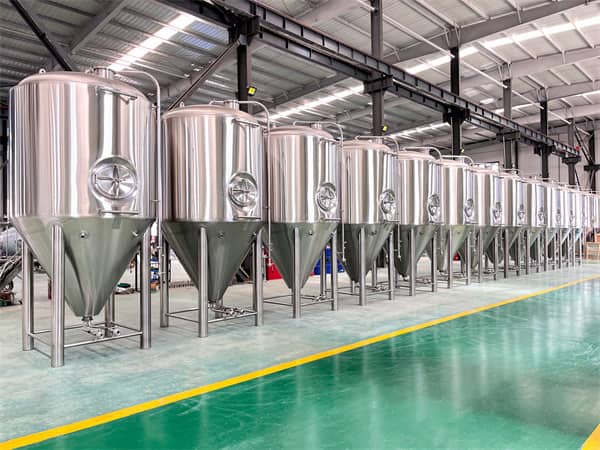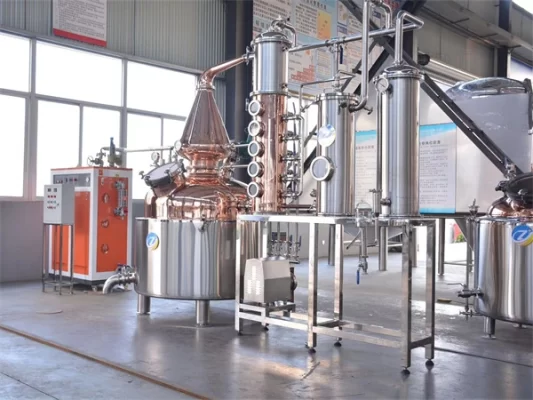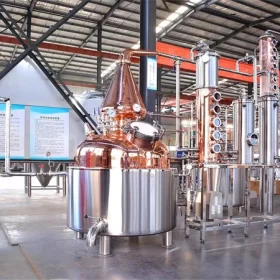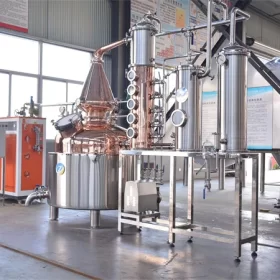Conical fermenter tanks, also known as uni-tanks or cylindroconical vessels, are essential equipment in the beer brewing process. These specialized tanks are designed to facilitate the fermentation stage, where yeast converts the sugars from the wort (unfermented beer) into alcohol and carbon dioxide. The conical shape of these tanks provides several advantages over traditional cylindrical fermenters, making them a popular choice among commercial breweries and serious homebrewers.
The unique design of conical fermenter tanks allows for efficient yeast management and separation during fermentation. The cone-shaped bottom acts as a natural settling area for the yeast, making it easier to harvest and reuse for subsequent batches. This not only saves on the cost of purchasing new yeast but also preserves the unique flavor profile contributed by the house yeast strain.
Conical Fermenter Tank Equipment Guide
Conical fermenter tanks typically consist of the following components:
| Component | Description |
|---|---|
| Cylindrical Body | The main cylindrical section of the tank, where the fermentation process takes place. It is typically made of high-quality stainless steel or other food-grade materials. |
| Conical Bottom | The cone-shaped bottom section, designed to facilitate yeast collection and separation. The angle of the cone can vary, but a steeper angle generally promotes better yeast collection. |
| Racking Arm | A movable arm or pipe located near the bottom of the cone, used for transferring the fermented beer (green beer) to the next stage, leaving the yeast behind. |
| Cooling Jacket | An optional feature that allows for temperature control during fermentation by circulating a cooling or heating medium around the tank’s outer surface. |
| Ports and Fittings | Various ports and fittings for attaching accessories like airlocks, sample valves, sight glasses, and clean-in-place (CIP) systems. |
| Insulation | Insulation around the tank helps maintain consistent temperatures during fermentation. |
Types of Conical Fermenter Tanks
Conical fermenter tanks are available in different sizes and configurations to suit various brewing operations. Here are some common types:
| Tank Type | Description |
|---|---|
| Unitank | A single-vessel system that combines the functions of fermentation, conditioning, and bright beer tank. It allows for the entire brewing process to occur in one tank, simplifying the workflow. |
| Open Fermenter | An open-top conical fermenter tank, often used for top-fermenting yeasts like those used in ales. The open design allows for easier access and addition of ingredients during fermentation. |
| Closed Fermenter | A sealed conical fermenter tank, commonly used for bottom-fermenting yeasts like those used in lagers. The closed system provides better control over the fermentation environment. |
| Jacketed Fermenter | A conical fermenter tank with an external jacket that allows for precise temperature control during fermentation. This is essential for certain beer styles that require specific temperature regimes. |
The Brewing Process with Conical Fermenter Tanks
Conical fermenter tanks play a crucial role in the beer brewing process, particularly during the fermentation and conditioning stages. Here’s a simplified overview of how they are used:
- Wort Transfer: After the wort (unfermented beer) has been boiled and cooled, it is transferred into the sanitized conical fermenter tank.
- Yeast Pitching: The appropriate yeast strain is added (pitched) into the wort, initiating the fermentation process.
- Primary Fermentation: As the yeast consumes the sugars in the wort, alcohol and carbon dioxide are produced. This primary fermentation stage can last several days to a few weeks, depending on the beer style and yeast strain.
- Yeast Settling: Once primary fermentation is complete, the yeast cells begin to settle towards the conical bottom of the tank, forming a compact yeast cake.
- Racking: Using the racking arm, the fermented beer (green beer) is carefully transferred from the tank, leaving the yeast behind. This process is known as racking.
- Conditioning: The racked beer may undergo additional conditioning or lagering stages in separate tanks or within the same conical fermenter, depending on the brewery’s process.
- Yeast Harvesting: The compact yeast cake collected at the bottom of the cone can be harvested and reused for subsequent batches, or discarded if a new yeast strain is needed.
This process highlights the efficiency of conical fermenter tanks in separating the yeast from the beer, enabling brewers to reuse their house yeast strains and maintain consistent flavor profiles across batches.
Conical Fermenter Tank Capacity, Spaces, Design, and Layout
Conical fermenter tanks are available in various capacities to accommodate different brewing scales, from small homebrewing setups to large commercial operations. The table below provides an overview of typical tank capacities and the corresponding brewing scales:
| Capacity Range | Brewing Scale |
|---|---|
| 5 – 15 gallons | Homebrewing |
| 15 – 30 gallons | Nano-brewery |
| 30 – 60 gallons | Small Brewery |
| 60 – 120 gallons | Mid-sized Brewery |
| 120+ gallons | Large Commercial Brewery |
When planning the layout and design of a brewery, several factors must be considered, including the available floor space, ceiling height, and the overall workflow. Conical fermenter tanks can be arranged in various configurations, such as:
- Linear Layout: Tanks are arranged in a straight line, suitable for smaller breweries with limited space.
- Circular Layout: Tanks are positioned in a circular or semi-circular pattern, allowing for efficient movement and access.
- Tiered Layout: Tanks are placed on different levels or platforms, maximizing vertical space in breweries with high ceilings.
The design of conical fermenter tanks also allows for customization and integration with other brewing equipment. For example, some tanks can be equipped with built-in cooling jackets or integrated with external glycol chillers for precise temperature control during fermentation.
Conical Fermenter Tank Suppliers and Price Range
Conical fermenter tanks are available from various suppliers catering to both commercial and homebrewing markets. The price range can vary significantly depending on the tank’s capacity, materials, features, and the supplier’s brand. Here’s a general idea of the price ranges for different brewing scales:
| Brewing Scale | Price Range (USD) |
|---|---|
| Homebrewing | $200 – $1,500 |
| Nano-brewery | $1,500 – $5,000 |
| Small Brewery | $5,000 – $15,000 |
| Mid-sized Brewery | $15,000 – $50,000 |
| Large Commercial Brewery | $50,000+ |
Some popular suppliers of conical fermenter tanks include:
- SS Brewtech
- Blichmann Engineering
- Omega Altanium
- Unitank
- Metalcraft Fabrication
- Stout Tanks & Kettles
It’s important to note that these prices are rough estimates and can vary based on specific requirements, such as custom sizes, specialized features, or bulk orders.
Installation, Operation, and Maintenance of Conical Fermenter Tanks
Proper installation, operation, and maintenance are crucial for ensuring the longevity and optimal performance of conical fermenter tanks. Here’s an overview of what’s involved:
| Aspect | Description |
|---|---|
| Installation | Proper placement and leveling of the tank, along with the installation of any accessories (cooling jackets, racking arms, etc.), plumbing, and electrical connections. |
| Operation | Following the correct procedures for sanitization, wort transfer, yeast pitching, fermentation monitoring, and racking. Maintaining appropriate temperature control and monitoring during the fermentation process. |
| Maintenance | Regular cleaning and sanitization of the tank and its components, following the manufacturer’s recommended cleaning procedures and cleaning schedules. Inspecting for any signs of damage, corrosion, or wear and tear. Performing necessary repairs or replacements as needed. |
Proper training and adherence to best practices are essential for brewery staff responsible for operating and maintaining conical fermenter tanks. Many suppliers offer comprehensive training programs and resources to ensure optimal usage and longevity of their equipment.
Choosing the Right Conical Fermenter Tank Supplier
When selecting a supplier for conical fermenter tanks, there are several factors to consider to ensure you make the right choice for your brewing operation:
| Factor | Description |
|---|---|
| Quality and Materials | Look for suppliers that use high-quality, food-grade materials like stainless steel or other approved materials for their tanks. The quality of materials directly impacts durability, sanitation, and overall performance. |
| Customization Options | Consider suppliers that offer customization options, such as custom sizes, specialized features (cooling jackets, racking arms, etc.), and the ability to integrate with your existing brewing setup. |
| Reputation and Customer Support | Research the supplier’s reputation in the industry and read customer reviews. A reputable supplier with excellent customer support can make a significant difference in ensuring a smooth purchasing and installation process. |
| Delivery and Installation Services | Inquire about the supplier’s delivery and installation services, especially for larger tanks. Professional installation can help ensure proper setup and alignment, minimizing potential issues down the line. |
| Warranty and Maintenance | Evaluate the warranty coverage and maintenance support offered by the supplier. A comprehensive warranty and readily available maintenance services can provide peace of mind and protect your investment. |
| Pricing and Value | While cost is an important factor, it shouldn’t be the sole consideration. Look for suppliers that offer competitive pricing while maintaining high-quality standards and providing value-added services. |
By considering these factors, you can make an informed decision and select a conical fermenter tank supplier that meets your specific brewing needs and budgetary requirements.
Pros and Cons of Conical Fermenter Tanks
Like any brewing equipment, conical fermenter tanks have their own set of advantages and limitations. Understanding these pros and cons can help brewers make informed decisions and determine if these tanks are the right fit for their brewing operations.
Advantages of Conical Fermenter Tanks
- Efficient Yeast Management: The conical shape allows for easy separation and collection of yeast, enabling brewers to reuse their house yeast strains and maintain consistent flavor profiles across batches.
- Improved Clarity: The compact yeast bed formed at the bottom of the cone results in clearer, brighter beer with fewer suspended particles.
- Space-Saving Design: Conical tanks have a smaller footprint compared to traditional cylindrical fermenters, making them ideal for breweries with limited floor space.
- Versatility: Conical fermenter tanks can be used for various fermentation styles, including ales, lagers, and spontaneous fermentation.
- Temperature Control: Many conical tanks are designed with cooling jackets or integrated temperature control systems, allowing for precise temperature management during fermentation.
- Closed System: Closed conical fermenters provide better control over the fermentation environment, reducing the risk of contamination and oxidation.
Limitations of Conical Fermenter Tanks
- Higher Initial Cost: Conical fermenter tanks are generally more expensive than traditional cylindrical fermenters, especially for larger capacities and specialized features.
- Cleaning and Maintenance: The conical shape and additional components (racking arms, cooling jackets, etc.) can make cleaning and maintenance more challenging compared to simpler cylindrical tanks.
- Potential for Stuck Fermentations: In some cases, the compact yeast bed at the bottom of the cone can become overly compacted, leading to stuck fermentations or slow fermentation rates.
- Limited Access: Closed conical fermenters have limited access points, which can make it difficult to monitor or add ingredients during fermentation.
- Weight and Mobility: Larger conical tanks can be heavy and difficult to move, requiring specialized equipment or permanent installations.
- Pressure Rating: Many conical fermenters are not designed to handle high pressures, limiting their use for certain brewing techniques or styles that require elevated pressure levels.
Ultimately, the decision to use conical fermenter tanks should be based on a careful evaluation of your brewing requirements, available space, budget, and overall brewing philosophy.
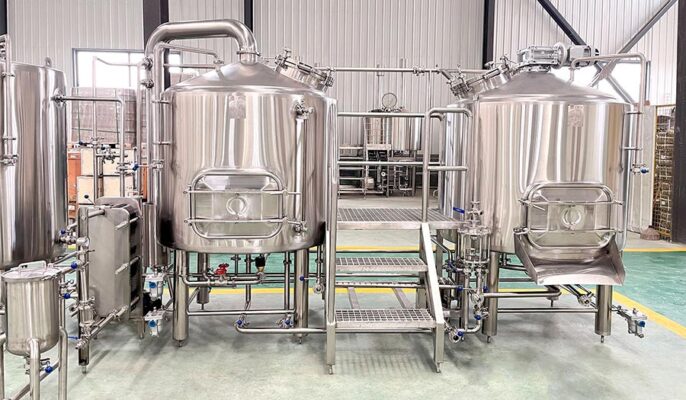
FAQs
| Question | Answer |
|---|---|
| What is the typical lifespan of a conical fermenter tank? | With proper maintenance and care, high-quality stainless steel conical fermenter tanks can last 10-20 years or more in a commercial brewing environment. |
| Can conical fermenter tanks be used for other purposes besides fermentation? | Yes, conical tanks can also be used for conditioning, aging, and even serving beer in some cases. Their versatile design makes them suitable for various stages of the brewing process. |
| How often should conical fermenter tanks be cleaned and sanitized? | Most brewers clean and sanitize their conical tanks after every batch or at least once a week, depending on their brewing schedule and standard operating procedures. |
| Can conical fermenter tanks be used for both ales and lagers? | Yes, conical fermenter tanks can be used for both ale and lager fermentations. The choice between open or closed fermenters depends on the specific yeast strain and fermentation requirements. |
| Are conical fermenter tanks suitable for small-scale homebrewing? | Yes, smaller conical fermenter tanks are available for homebrewing setups, offering the benefits of efficient yeast management and improved clarity on a smaller scale. |
| How do I prevent stuck fermentations in conical fermenter tanks? | Proper yeast management, temperature control, and regular rousing (mixing) of the fermenting beer can help prevent stuck fermentations caused by compacted yeast beds. |
| Can conical fermenter tanks be customized to specific brewing requirements? | Many suppliers offer customization options for conical fermenter tanks, such as custom sizes, specialized fittings, and integrated cooling or heating systems. |
| How does the angle of the conical bottom affect yeast collection? | A steeper angle on the conical bottom generally promotes better yeast collection and separation, but the optimal angle may vary depending on the yeast strain and brewing conditions. |




